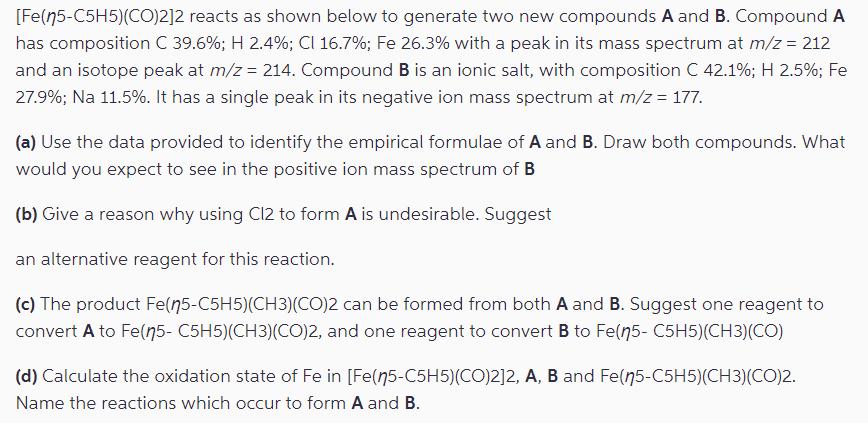Answered step by step
Verified Expert Solution
Question
1 Approved Answer
[Fe(n5-C5H5)(CO)2]2 reacts as shown below to generate two new compounds A and B. Compound A has composition C 39.6%; H 2.4%; CI 16.7%; Fe


[Fe(n5-C5H5)(CO)2]2 reacts as shown below to generate two new compounds A and B. Compound A has composition C 39.6%; H 2.4%; CI 16.7%; Fe 26.3% with a peak in its mass spectrum at m/z = 212 and an isotope peak at m/z = 214. Compound B is an ionic salt, with composition C 42.1%; H 2.5%; Fe 27.9%; Na 11.5%. It has a single peak in its negative ion mass spectrum at m/z = 177. (a) Use the data provided to identify the empirical formulae of A and B. Draw both compounds. What would you expect to see in the positive ion mass spectrum of B (b) Give a reason why using C12 to form A is undesirable. Suggest an alternative reagent for this reaction. (c) The product Fe(n5-C5H5)(CH3)(CO)2 can be formed from both A and B. Suggest one reagent to convert A to Fe(n5-C5H5)(CH3)(CO)2, and one reagent to convert B to Fe(n5-C5H5)(CH3)(CO) (d) Calculate the oxidation state of Fe in [Fe(n5-C5H5)(CO)2]2, A, B and Fe(n5-C5H5)(CH3)(CO)2. Name the reactions which occur to form A and B.
Step by Step Solution
There are 3 Steps involved in it
Step: 1

Get Instant Access to Expert-Tailored Solutions
See step-by-step solutions with expert insights and AI powered tools for academic success
Step: 2

Step: 3

Ace Your Homework with AI
Get the answers you need in no time with our AI-driven, step-by-step assistance
Get Started


